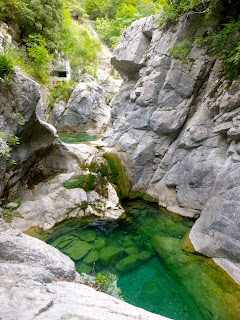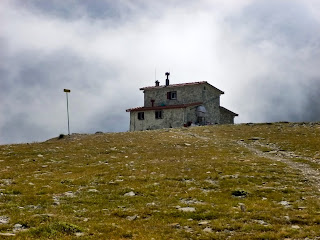Wildlife of Spain’s Sierra Nevada
Spain’s Sierra Nevada
region is unique in that its altitude spans a massive height difference from
about 700m above sea level to the Lofty Mulhacen at 3482m. This give it several
distinct climatic zones with a huge degree of biodiversity coupled with over
100 endemic species including 63 endemic species of plant. It is situated about 50 miles east of Malaga on the south coast of Spain and just to the south east of the city of Granada and a day out in the Sierra Nevada mountains makes a great option if you are visiting Granada.
 |
| Satellite image of The Sierra Nevada showing proximity to the sea. The area in white is snow covered mountains. |
The Sierra Nevada was
first recognised in 1986 when it was awarded the status of being a UNESCO
Biosphere Reserve. In 1989 it was
awarded “Natural Park” status and in 1998 the central area was awarded National
Park status becoming Spain’s 11th National Park.
In terms of size, The
Sierra Nevada National Park is Spain’s largest with some 330 square miles. It
is surrounded by the Sierra Nevada Natural Park of some 340 square miles, so
together they are a massive 670 square miles.
 |
| The Sierra Nevada, National Park in green, Natural Park in Blue |
The land inside the
National Park enjoys a higher level of protection. Additionally, people live
within the Natural Park (similar to U.K. National Parks), whereas there are no
permanent human settlements in the National Park, only summer farms. The Padul
Ponds at the western end of the range are significant wetlands and being in the Natural Park also enjoy a higher level of protection.
To describe the Sierra
Nevada we generally divide it into “climatic zones” which have their own
characteristics in terms of wildlife though some species (Iberian Ibex, eagles,
vultures, etc.) transcend all zones. The only zone that we describe that is not
climatic in the same sense is the limestone area of the western edge of the
Sierra Nevada which due to its geology has it’s own unique flora.
Mediterranean
Altitude typically below 800m
Terraces of citrus, olives and small holdings.
 |
| Wild flowers on the hillside in spring |
 |
| Purple salsify, Tragopogon porrifolius |
Birds: Crag
Martins, Bee Eaters
Animals: Iberien Ibex, common Genet.
Plants: Herbs!
Spring arrives early
here, when we can enjoy the terraces of almond, which flowers from February, and
citrus where the air can be scented with orange blossom in March and April.
Migratory birds are passing through or arriving to nest from March. Wildlife
walks at this height are at their best from March through to May.
High Villages and Farms (e.g. Alpujarra)
Altitude typically
700m to 1600m.
Terraces of Olives,
Almonds, Wallnuts, Chestnuts, cherries. Small holdings with Sheep and goats.
Animals: Wild Boar, Iberian Ibex.
Spring starts with the almond blossom, often in February. However it is still a little early to enjoy much else and the weather is still cool. By the end of March the orchids are starting to flower and all through April and May the flowers are stunning and the migratory birds are arriving back. By June it is getting hot at this level so we now turn our attentions to higher altitudes.
 |
| Typical Alpujarran landscape, early spring. |
Animals: Wild Boar, Iberian Ibex.
Plants: Various Orchids, Iris, Rosey Garlic.
Herbs, Jerusalem sage
Herbs, Jerusalem sage
Spring starts with the almond blossom, often in February. However it is still a little early to enjoy much else and the weather is still cool. By the end of March the orchids are starting to flower and all through April and May the flowers are stunning and the migratory birds are arriving back. By June it is getting hot at this level so we now turn our attentions to higher altitudes.
 |
| Shepherds walking with their flocks of sheep and goats are a common sight |
Low Alpine and Summer Farms (Transhumance)
Altitude typically
1600m to 2300m.
Chestnuts and
Wallnuts, summer farms.
 |
| Resting beside an acequia |
 |
| The Sierra Nevada Blue - Polymaths golgus |
Animals: Wild Boar, Iberian Ibex. Polyommatus golgus butterfly
Plants: St Bruno’s Lilley, Verbascum nevadense, Pyrenean Oak, Holm Oak.
Although it is
possible to explore this area in April or May, it is really in June and July
that the area is at its best with lovely meadows and flowers, bubbling streams
and examples of summer farming (transhumance) still being practised.
Altitude
typically 2300 to 3000m
Cows grazing “wild”
during the summer. Sheep and goats led here daily in summer.
 |
| Spring flowers (mid June) in the mid alpine zone, here an abundance of Broom! |
 |
| Broom - Cytisus galianoi |
Animals: Iberian Ibex, Beetles, Parnassius apolo butterfly
Plants: Junipers, Brooms, Gentians, Snow Star, Senecio boissieri
To experience the
mountainside coloured yellow as the brooms are in flower is a remarkable sight!
Herbs in flower with the Broom provides a great setting for butterflys,
especially the white Parnassius and the Sierra Nevada Blue. In the wetter areas
we are treated to a festival of flowers, gentians and the emblematic Star of
the Snows. Mid June and through July are the best months.
 |
| The White Apollo butterfly, Parnassius apolo feeding on Thyme |
 |
| Goats grazing amongst the rocks |
 |
| Senecio Boissieri, endemic to the Sierra Nevada and Sierra de Gador |
High Alpine
Altitude typically above 2900m – “Siliceous High Alpine Grassland”
Fortunately the National Park "Interpretation" Service provides busses to 2700m on the south side of the range and to 3000m on the north side making this area relatively accessible.
Fortunately the National Park "Interpretation" Service provides busses to 2700m on the south side of the range and to 3000m on the north side making this area relatively accessible.
 |
| Viewpoint near the bus drop off at 3000m on the north side of the Sierra Nevada |
 |
| Iberian Ibex, Capra pyrenaica, a common sight. |
Animals: Iberian Ibex, Butterflys
Plants:
Vegetation is scarce, often rare and unique,
Tyme,
Artemisia_granatensis,
Viola crassiuscula,
Chaenorrhinum glareosum,
Erigeron frigidus,
Leontodon boryi,
Papaver lapeyrousianum, etc.
Artemisia_granatensis,
Viola crassiuscula,
Chaenorrhinum glareosum,
Erigeron frigidus,
Leontodon boryi,
Papaver lapeyrousianum, etc.
This is a magical zone of many endemic and rare plant species, where swifts and swallows soar and dance in the air, where eagles and vultures ride thermals and “Cabra” – Iberial Ibex frequent close to humans hoping to pick up left over sandwiches! When to come very much depends on how much snow there has been. It’s sually o.k. from mid June and most flowers can be seen through until the end of July.
 |
| The endemic Sierra Nevada Violet, Viola crassiuscula |
 |
| Alpine Accentor - Prunella collaris |
Erigeron frigidus - Cold Fleabane, a rare endemic plant growing at over 3000m, it is thought only 130 specimens remain.
|
Borreguiles - High Altitude wetland areas
Altitudes typically
between 2600m and 3100m
Famous especially for
plants: Veronica nevadensis, Gentiana sierrae, Estrella de las Nieves, Lotus
glareosus, Thin Spurred Butterwort – Pinguicula nevadensis.
 |
| Near Pico del Caballo |
 |
| Lotus glareosus, gravel birdsfoot with gentians and snow stars |
 |
| The emblematic Star of The Snows, Plantago navalis |
 |
| The endemic Gentian, Gentiana sierrae |
Limestone of the Western Edge
The limestone extends
from lower altitudes (Niguelas 950m, Monachil 700m) to the impressive summit of
Trevenque 2080m.
Plants: Lavenders,
Rosemary, Echium albicans, Convolvulus boissieri, Paeonia coriacea, Junipers
 |
| The path to Trevenque showing a limestone desert! |
 |
| Echium albicans (Boragináceas) |
Brooms, Holm Oak, rock rose
This area is dominated
by the impressive Trevenque 2080m, sometimes described as the Matterhorn of the
Sierras. A walk to or around Trevenque rarely disappoints between mid April and
June. You will almost certainly see Ibex on Trevenque, but it is the plants
that are different here to the rest of the Sierra Nevada.
 |
| Paeonia coriacea |
 |
| Convolvulus Boissieri |
 |
| Heath Fritillary - Melitaea athalia |
Michael Hunt and Jane Livingstone are both International Mountain Leaders based at their Mountain House at 1300m above Lanjaron. IML’s are trained and assessed in environmental issues and environmental interpretation in addition to mountain guiding. Their walking holidays – “Mountain Walking Holidays” offer Wildlife of the Sierra Nevada Walking Holidays or alternatively if you are in the area, and want a day trip to explore some of the wildlife, this can be arranged through Sierra Nevada Guides.
Michael and Jane have
been exploring the Sierra Nevada since 2003.





























